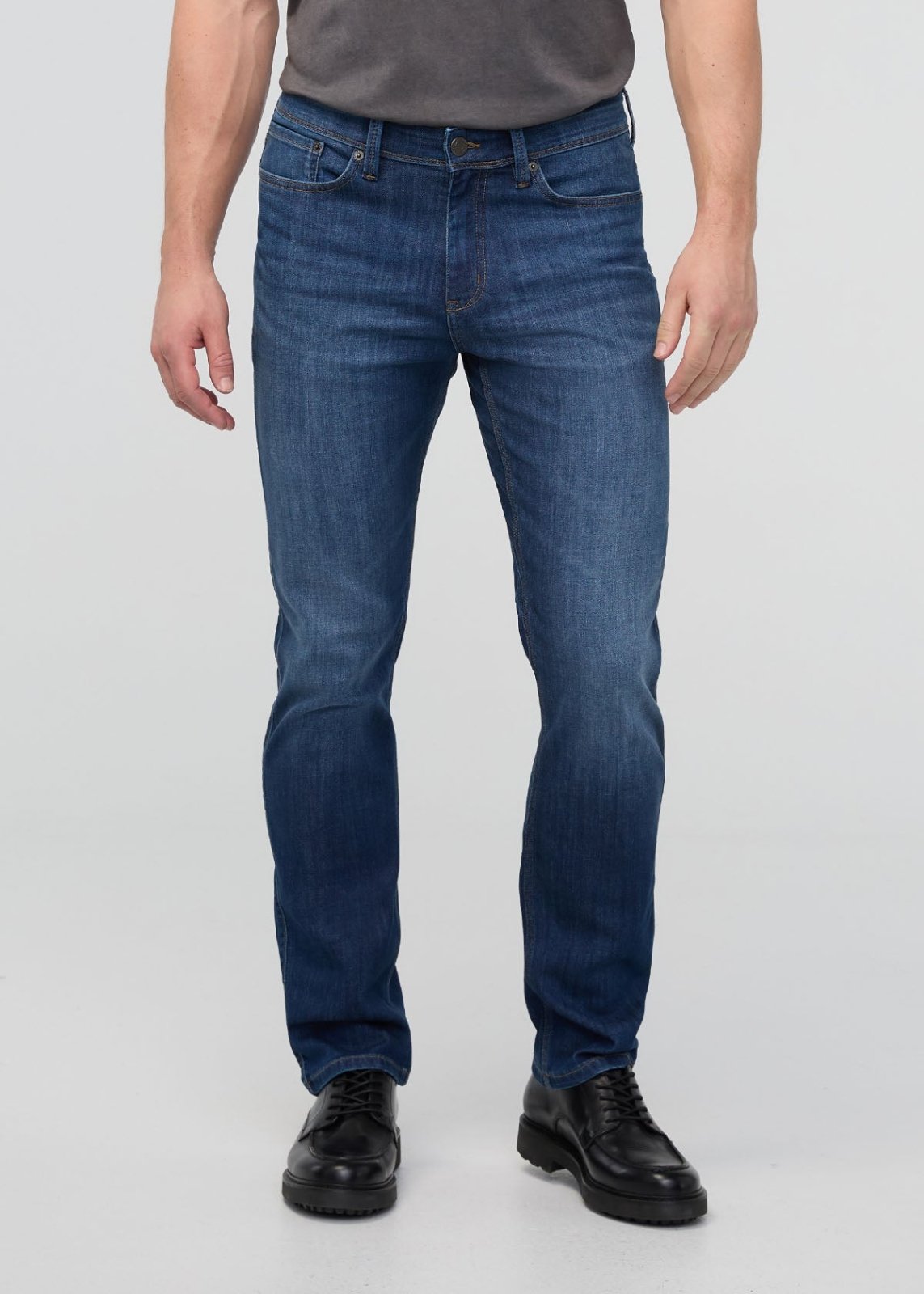From the indigo blue of raw denim to the distinctive faded patterns of acid wash, the range of denim finishes we see in our everyday life is vast and diverse. Behind these varying aesthetics lies a fascinating process, marked by a delicate balance of science, craftsmanship, and creativity. Welcome to the world of denim washing - a process that transforms raw fabric into the soft, stylish, and comfortable denim that is a staple in wardrobes worldwide.
We sat down with our Product Manager, Lucia, the true denim wash expert to find out more about our Performance Denim wash process. Lucia has been working with denim for over twenty years, so if there’s anyone that understands denim washes, it’s her.
Washed Denim vs. Raw Denim
What is Raw Denim?
Raw denim, also known as dry denim, is denim in its purest form. It's the closest you can get to denim straight from the loom, without any washing or treatment applied. The material is stiff and has a deep indigo color. Over time, raw denim molds to the wearer's body shape and natural wear patterns, creating unique fading lines and whiskers. This feature has made raw denim particularly popular among denim enthusiasts and purists, who enjoy the process of breaking in their denim and creating their personalized wear patterns.
Raw denim requires special care to maintain its quality and prolong its lifespan, including infrequent washing and mindful storage.
What Is Washed Denim?
Washed denim, as its name implies, refers to denim fabric that has undergone a washing process to alter its color and texture. This process involves the use of chemicals, stones, or other natural agents, with the intention to either lighten the color or create a specific pattern on the fabric. The washing procedure also softens the material, making it more comfortable to wear from the first use.
Various types of denim washes exist, including acid wash (where bleach is used to create a contrasted, mottled appearance), stone wash (where pumice stones add a faded look and softer feel), and vintage wash (where the denim is distressed to mimic a worn-in, retro aesthetic).
What are the Denim Wash Types?
There are 8 main types of denim washes: acid, bleach, enzyme, lazer, monkey, rinse, sand, and stone washes. Different denim washing techniques result in distinct looks and feels, giving designers a range of options when it comes to creating their denim garments. The following are some examples of techniques of achieving washed denim:
Acid Wash
Acid washing, also known as marble washing or snow washing, is a process that creates a high-contrast, mottled effect on denim. The jeans are first soaked in chlorine bleach, then washed with pumice stones. The bleach removes the indigo dye, while the stones create a pattern of dark and light patches.
Bleach Wash
In the process of a bleach wash, denim is soaked in a diluted bleach solution to strip away its color. The bleach breaks down the dye in the fabric, leading to a lighter, faded appearance. This process can be controlled to achieve a range of shades from light blue to nearly white. The result is a uniformly lightened garment without the high-contrast, marbled look of acid wash.
Enzyme Wash
Enzyme washing is a more eco-friendly alternative to stone washing, using biological enzymes to break down the dye. The enzymes "eat away" at the indigo, creating a faded look without the need for harsh chemicals or the physical abrasion of stones. This method not only provides a softer feel to the fabric but also causes less damage to the denim's fibers, prolonging the lifespan of the garment.
Laser Wash
A more recent and sustainable denim washing technique is laser washing. Lasers are used to burn off the indigo dye, creating fading and whiskering effects without the use of water, stones, or chemicals. This method also allows for a high degree of precision and customization, as designers can program the lasers to create specific patterns and designs.
Monkey Wash
Monkey wash involves treating the denim fabric with chemicals, then scrubbing it with rubber balls or pumice stones to achieve the desired effect. This creates unique patterns of wear and fading that can mimic the natural aging process of denim. The resulting denim has a rugged, lived-in aesthetic that's desirable in many fashion circles. The name "monkey wash" comes from the unique and random patterns created, which are often associated with the playful and unpredictable nature of monkeys.
Rinse Wash
A rinse wash is one of the most basic washing processes in denim manufacturing. In this process, denim jeans are simply rinsed in water and then softened with softeners. The main goal of a rinse wash is to make the denim softer and more comfortable to wear. This type of wash removes the residual dye and prevents further color bleeding. It gives the denim a cleaner, more uniform appearance, but does not significantly alter the color or create a worn-in look like more extensive washes.
Sand Wash
Sand wash sprays the denim with large amounts of sand, to create friction between the denim and sand to achieve a faded, worn look. It can be targeted to specific areas of the garment for a unique pattern or used all over for a uniform effect. The end result is a softer and lighter colored denim with a distinctly vintage appeal.
Stone Wash
Stone washing is a common method used to give denim a worn, faded look. As the name suggests, this process involves washing the denim with pumice stones. The stones physically beat the fabric, breaking down the indigo dye and the fiber structure, resulting in a softer, more flexible material with a naturally aged appearance.
Whiskering
Denim whiskering not a wash, but the faint, horizontal crease lines that appear around the crotch and hip area of a pair of denim jeans. These lines resemble the pattern of a cat's whiskers, hence the name.
The whiskering effect is achieved through a process of washing and distressing the denim, usually done by hand or with a laser. The goal is to mimic the natural wear-and-tear pattern that would occur over time from regular use. This gives the jeans a well-worn, vintage look from the moment you buy them.
What Is Unwashed vs Rinsed Denim?
Rinsed denim is a form of raw denim that has been lightly washed to remove the starch and excess indigo dye that comes with raw denim; whereas unwashed denim, or raw denim, is untouched by water or chemicals in any way.
What Is the Difference Between Rinse Wash and Stone Wash?
A rinse wash involves cleaning the denim with water, softening the fabric and slightly fading its color, while a stone wash incorporates pumice stones in the washing process, leading to a significantly faded, worn-out look with a softer feel due to the high abrasion.
From Raw to Washed Denim: Step-By-Step Process at DUER
Let’s take a deeper look into the process with (3) easy steps:
1. Choosing a Fabric
When nailing down the perfect wash, one of the most important components is the fabric. Performance attributes like Coolmax, stretch, and anti-bacterial applications can have an effect on the appearance of the wash. For that reason, we choose a fabric that’s dark and rich in colour to get the maximum amount of wash range.
2. Testing Washes for Inspiration
Once we’ve chosen a denim fabric, we work with the laundry also known as ‘wash house’ to develop a base wash colour palette. Building out a wash palette provides us with reference when gathering inspiration for future denim washes - and to keep ahead of the trends.
Choosing a wash palette is done by putting the fabric through wash cycles with enzymes, washing agents, and lava stones. This breaks down the denim and creates unique washes to alter the dark blue colour in the original fabric.
3. Styling the Wash
This is the most important step in the denim washing process as it determines the style of the denim wash. For instance, you can whisker the denim, or hand sand the denim. Whiskering creates the light markings across the thighs, whereas hand sanding creates the washed out look usually around the pocket and knee areas. Both these processes give the denim a worn out or vintage look.
The Art of the Perfect Washed Denim Jeans
The creation of the perfect wash is not merely a process but an art, combining the aesthetic vision of designers with the science of fabric treatment. From the conventional stone washing method to the more eco-friendly enzyme and laser washing, a multitude of techniques exist, each contributing to the vast variety of denim finishes we see in the market today.
At DUER, we blend science and art in our washing process, putting our performance denim fabric through various cycles to achieve our signature wash range. The final step of styling the wash allows us to add individual character to each pair of jeans, creating the distinctive whiskering and hand sanding effects.
Just like that, you now know most of the story behind our washing process for Performance Denim. Shop our Performance Denim washing for men and for women.












































